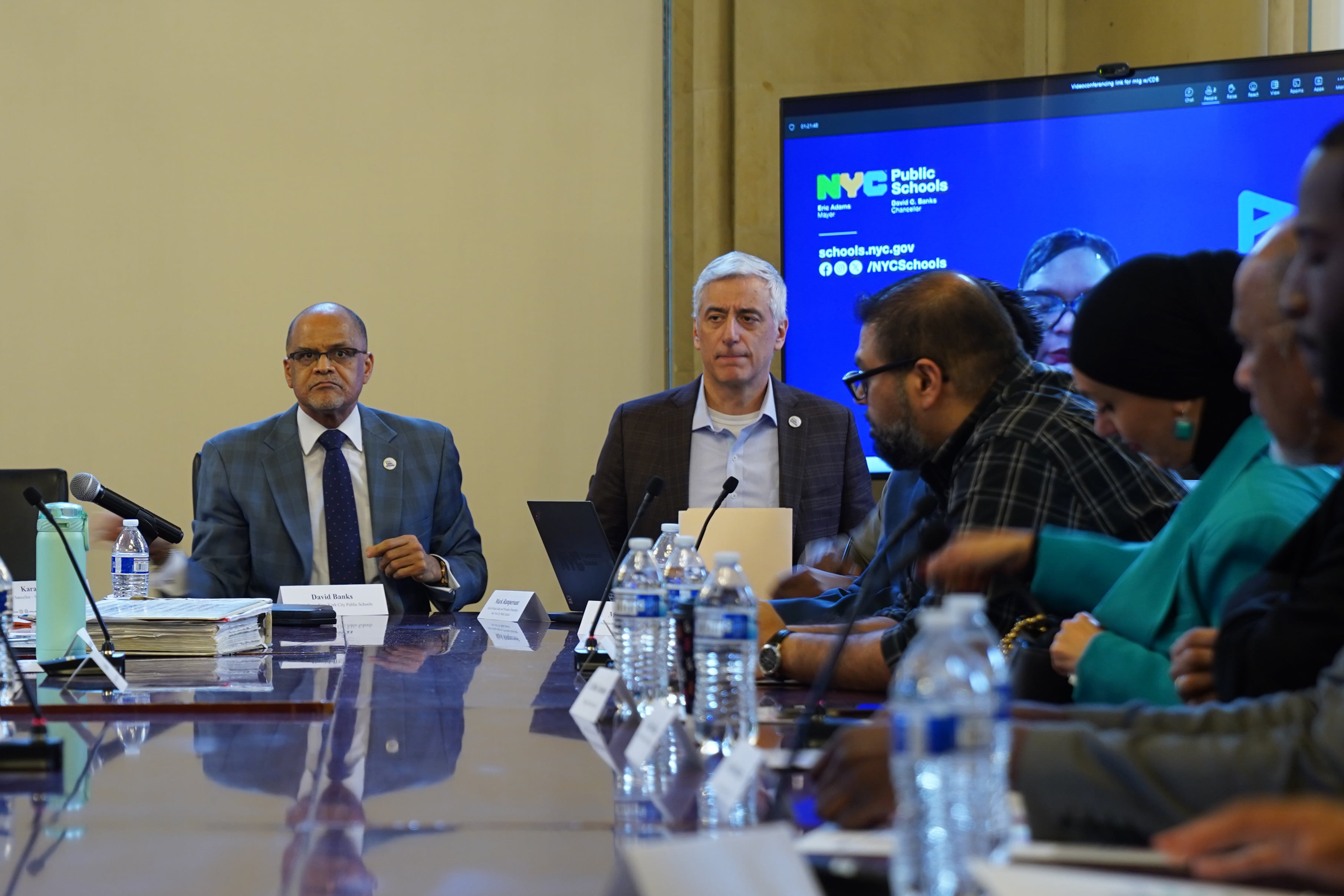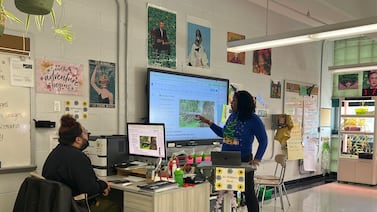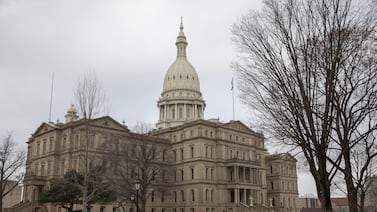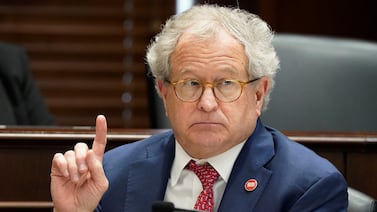Sign up for Chalkbeat New York’s free daily newsletter to get essential news about NYC’s public schools delivered to your inbox.
He shepherded the mayor’s curriculum overhauls, pushed to open 28 new schools, and even helped elevate Melissa Aviles-Ramos as chief of the nation’s largest school system.
Now, after three and a half years as the Education Department’s second-in-command, Dan Weisberg is stepping down.
Weisberg oversees a massive portfolio that includes Adams’ biggest education initiatives, including reading and math curriculum mandates known as NYC Reads and Solves, and a pathways program to connect more students to career options before graduation.
“Dan was at the center of all our critical work,” Aviles-Ramos said in a statement. “He has led with integrity, dedication, boldness, and care, pushing relentlessly for innovation and equity in our schools.”
Weisberg has also amassed his share of critics, including advocates who point out that the Education Department has not prioritized school integration — and it has advanced policies that they fear will worsen the problem. He got his start in the Education Department as a labor negotiator during the Bloomberg administration, often clashing with the teachers union, which initially raised alarms about his leadership but more recently has praised some of his work expanding teacher training.
As Weisberg prepares to leave the department next month, Chalkbeat caught up with him about his assessment of the school system’s health, mixed results of the city’s reading curriculum overhaul, how immigration crackdowns could affect enrollment, and what he makes of Zohran Mamdani’s education promises.
This interview has been edited for length and clarity.
You’ve been the second in command at the Education Department since Eric Adams took office and you previously mentioned that you’d stay in the position as long as the mayor and the chancellor wanted you in the role. I’m wondering what changed?
Nothing changed. It was a good time to transition — it being the summer, the school year has ended. Honestly, this is not a job you ever want to do if you’re not feeling like you have the energy to give it 100%. It does take a lot out of you, and it’s time for me to get a little bit of downtime. I feel very good about where we are with the work, and feel very good about the strength of the team, so that made it a good time to transition.
What is your zoomed out assessment of the school system compared with four years ago? When the mayor came into office, he spoke pretty passionately about how it was unacceptable that large majorities of Black and Latino children weren’t proficient in reading and math. There’s been some progress under your watch, but it’s still the case that more than 60% of those kids are not considered proficient on state tests.
I appreciate you raising the mayor’s words and former Chancellor Banks’ words which I think was really important. That needed to happen before we could make some pretty fundamental changes.
I may have more perspective after I’ve gotten a chance to take a breath. But what I would say is that kind of problem where we are not serving the large majority, frankly, of our students well academically is not going to be solved by tweaks. We really needed some fundamental changes in the way we approach teaching reading and math. Even though we haven’t really launched it yet, we have work to do when it comes to all of our core academic subjects.
As we said right from the start, this is not something that’s going to show immediate returns on test scores, but it will show returns. And so I would say, if we stay the course with this general approach to curriculum instruction, you know, eight years from now, we will see steady, significant gains. And a much higher percentage of our students, including our Black and Hispanic students, our students with disabilities, our multilingual learners, all doing much, much better than they’re doing now.
If you’re thinking on an eight-year time horizon, that could be multiple mayoral administrations from now. So far, it seems like the evidence is mixed: state test scores went down a little bit last year [in reading] — the screener data is maybe a little more encouraging, but not definitive. People are going to have to make decisions about this program before maybe you would like them to. Are you worried about that?
Political transitions are a fact of life. And this is not a surprise to us. The way you ensure sustainability across administrations is to do a really good job at implementation and a really good job at listening to people in the field and adjusting. And I think the chancellor deserves tremendous credit for doing that. She’s got her ear very close to the ground with teachers in the classroom, with principals, with superintendents, with our union partners. Ultimately, if the people in the field doing the hard work of educating our kids think this is the right approach — very, very unlikely that a new administration, whether it’s a second term, whether it’s a new administration, are going to alter that.
What are some of the biggest goals that you came in excited about that you didn’t make as much progress on as you hoped?
You’re always hoping for very rapid progress, but that doesn’t usually happen. When Chancellor Banks and I and the team were preparing during the transition to enter office, one of the things that I was pretty strenuous in advising is it’s very important, particularly in a big complex system like this one, to have a very short list of priorities. There’s limited capacity, there’s limited time in the day, there’s limited attention, there’s limited budget. If you have a list of 10 big priorities, in my view, you might as well have a list of a million or zero.
Our focus has been very clear: New York City Reads, New York City Solves, student pathways. Truly in all of those areas, I feel like we both did the foundational work, the building blocks are in place, and have made progress in implementation. [It would] be wonderful if we could say we already have 100,000 kids getting career-connected learning opportunities connected to specific pathways. We’re not there yet. We didn’t expect to be there yet. I’m not disappointed by that, but I’m certainly eager for us to continue to scale that work.
This is not just me saying, ‘Hey, everything’s wonderful.’ We very specifically, strategically kept a short list of priorities. And I think in part, as a result of that, we were able to see real, tangible progress in each of those areas.
If Zohran Mamdani becomes mayor, his top youth-focused agenda item is free child care. What do you make of that proposal? And as someone who has worked in a big, complicated system what would it actually take to stand that up?
I can’t imagine anybody who’s mayor or aspiring to be mayor of New York City, not seeing access to child care is a big issue. It’s a great ambition.
We have seen with providing 3-K and pre-K, it can be hugely positive. It is very difficult to implement. We depend on a pretty complicated system of providers. It’s not just, you know, our schools, which is complicated enough to manage, but it’s many of our [community based organizations], and they need to be at the heart of this system. And I think if the system gets extended to younger ages those CBOs are going to be a critical part of that as well. And that’s just a really complex system to try to manage well. We’ve seen this, particularly with 3-K, I think we made a lot of progress there, it is very difficult for any school system serving any age to respond quickly to changes in demand.
Mamdani has also proposed to end mayoral control in its current form. Do you think there’s an appetite in Albany to end the governance system that has existed since the Bloomberg administration?
Yeah, yes. It would be a massive mistake to end mayoral control. What’s the old quote? Democracy is the worst system except for all the others.
And I get it, people have a lot of frustration with our current governance system because anything that’s wrong with the system gets laid at the feet of this governance system. I came up through the public schools under a very different governance system, and it was far, far worse. The student outcomes were worse, the student experiences were worse, the family experiences were way worse, the Byzantine bureaucratic structure. I know we have our problems with bureaucracy, but it is nothing compared to what was when you had a fragmented system.
Former Chancellor Banks called the influx of migrant students a “godsend” for helping stabilize enrollment. I’m wondering if you’re seeing any evidence now of those students leaving and whether there’s a danger that federal immigration policy could drive down immigrant student enrollment?
I wouldn’t say we’re seeing evidence of that at a system level. We’re not seeing big swings — reductions in enrollment. Certainly anecdotally, that is happening in places. And it’s a huge worry.
Immigration is not just the lifeblood of our city and and always has been, but it’s the lifeblood of our school system. We had a significant influx of new New Yorkers over the last several years, but we have steady immigration and new families coming into our school system all the time. And so even without the influx, if we see major decreases in the number of new families coming to New York City [and] enrolling their kids, that’s going to have a very negative effect on our schools. So I absolutely worry about that. I’m talking about legal immigration, where it’s just families coming into the country. We’ve been blessed with wave after wave of immigration, even aside from, you know, the big influx that happened the last couple of years. And we need that to continue.
One of the biggest things the next mayor is going to have to manage is the class size mandate. Zohran Mandani said recently he thought that the Education Department hadn’t been taking the mandate seriously enough. There’s been some critique about whether the city has done enough to plan to get to 100% compliance and make it clear how that’s going to happen. I’m wondering what your response is to those critiques? A big component of the mandate is going to be to hire thousands of new teachers and also curious whether those teachers exist?
The critiques about us not taking it seriously are a head scratcher. We have complied. Some of these critics may not like the way the law is set up, but the law is very clear. We have to get the 20% [compliance] and then an incremental 20% every year. As you know, we have done that, and we’re going to do that for next year as well. We have done that in part through the infusion of hundreds of millions of dollars. I don’t know what indicates more seriousness than allocating significant budget to an issue.
We have some mechanisms to increase our pipeline. We have done that primarily through our alternative certification programs, our teaching fellows programs, which have been at times in the past much bigger. We’ve done that this year, doubled the class. We can work with our higher ed partners to see if they can expand, but it is going to be a stress and a strain.
We need to expand the talent pipeline. And the best way to do that, in my view, is creating a really robust paraprofessional teacher career pathway. But suffice it to say, if we are in a situation where we’re going to need to hire, call it 7,000 teachers a year versus 4,000, then we’re going to have to do things differently. We’re going to have to innovate. The solutions to that right now are not in place.
Another huge priority has been opening new schools. Many of those have been screened programs and the administration has made the argument that’s to give families more high-quality options in high-need neighborhoods. At the same time, enrollment is declining over the last several years, so that could lead to a greater number of unsustainably small schools, and it could also lead to more academic segregation. How did you weigh those trade-offs?
The guiding light for us is around community demand. The fact that we opened [Bard High School Early College Bronx], and [Bard High School Early College Brooklyn] was not because the chancellors and I said, ‘Hey we think it’d be a cool idea to open an early college school in these areas.’ It’s because there was demand. We can be guided by our own opinions about what families should want. Some school system leaders have led that way, and if the people we serve don’t agree with you, you’re going to be speaking to an empty room.
Birth rates are dropping. As you say, there may be some variation in immigration patterns. There’s still lots and lots of New Yorkers who choose not to enroll their kids in New York City public schools. In some cases, they decide to leave because they’re not getting what they want from the school system.
This is a longer conversation maybe we’ll get to have at some point — the idea that, hey, we’re going to take the high performing kids and put them in certain schools, and that’s going to leave low performing kids in other schools. You remember that LeBron James commercial where he’s [talking about] kids from humble beginnings? My hope is that there’s no more humble beginnings if we get really good at catching kids up, which is, by the way, the next New York City Reads and Solves challenge that we are taking on in a big way.
We have to get away from the scarcity paradigm, which is there’s only a static number of high performing kids, there’s a huge number of low performing kids, there’s a static number of good schools and a static number of bad schools. If we get really good at catching kids up, then whether you’re in a screened school, whether you’re an arts oriented school, a science oriented school, whether you’re just into the comprehensive high school, you’re going to get a good, solid education.
I do have to ask what you’re planning to do next.
Well, that’s probably the easiest question you’ve asked, because right now, I’m going to take some downtime. I’m going to spend a little time with family and just taking a breath, and I will be back in the fight somewhere, but I don’t know where at this point.
Alex Zimmerman is a reporter for Chalkbeat New York, covering NYC public schools. Contact Alex atazimmerman@chalkbeat.org.






